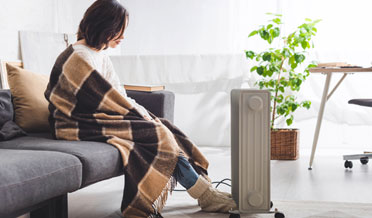9 Space Heater Safety Tips
Space Heater Safety Tips
After you have exhausted every other measure to keep the space in your home or office comfortable during the winter months, you have now come to the conclusion that a space heater is a proper resolution.
Tragically, space heaters are involved in thousands of house fires each year, and you need to ensure your safe using a space heater. What precautions should you take?
Before you buy. While considering your purchase, look for these key features for the safest heater possible.
- Check for Safety Certifications. Whether making a purchase online or in person, insist on buying a safe product. Look for safety certifications from governing agencies on websites or on labeling. We are used to seeing the UL rating (Underwriters Laboratories) in the U.S., but also look for ETL or CSA safety certifications, depending on the country of origin. Safety certifications will ensure that your purchase has been independently tested for safety and give you confidence in using it in your home.
- Size Matters. Buy a space heater designed to heat the size room that needs the help. It will disappoint if it is underpowered for the space.
- Automatic Shut-off. Look for a space heater with automatic shut-off capabilities. Sensors in newer models can detect moisture and shut off to prevent electric shock. They will also shut off should the heater tip over or overheat. These conditions are the leading cause of injury and death and are worth the search.
Before you use. After you have made your purchase, but before you turn it on, here are some Space Heater Safety Tips:
- Appropriate Detectors. Your home should be equipped with carbon monoxide and smoke detectors. Before using your new space heater, remember their locations, check their functionality and replace batteries regularly. Test your detectors on a monthly basis—just push the red tester button and listen for the loud beep.
- Read Safety Precautions. Safety guides and instruction manuals should be kept handy, but chances are you will forget their location shortly after your purchase. Reading the guide before plugging it in will help you operate the heater properly and avoid mistakes that can lead to dangerous situations.
Putting it To Good Use. The Instruction Manual should cover these Space Heater Safety Tip precautions:
- Proper Placement. Key things to remember about space heater placement:
- Place it on a level, hard surface, such as a floor. Do not set it up high on a table or countertop.
- Keep away from moisture or wet surfaces.
- Do not use in the presence of flammable gases, including a garage or workshop.
- Do not use in the presence of wet paint.
- Make sure to place the heater at least 3 feet away from any wall, furniture, drapes, etc., that can catch on fire.
- Do not place the heater in a high-traffic area.
- Make sure that pets and small children are kept well away from the space heater. Space heaters should not be used in children’s bedrooms overnight.
- Pull the Plug. Never leave a space heater in operation while away from home. Do not use a space heater overnight. In an abundance of caution, the Instruction Manual will state “Turn the device off and unplug the heater when not in use.” Make sure to grasp the plug at the outlet to unplug it. If the connection at the plug is loose or the wire frayed, make repairs before using the heater.
- Power Down. Electric space heaters use tremendous amounts of energy. Be wise and avoid problems. If the controls are set at the highest power setting, it may trip the breaker and it definitely will cost more to heat the space than you wish to pay. Instead, set the control at half power and be patient.
Want to Learn More About Space Heater Safety Tips?
Our four decades of experience as a Houston Electrician and contractor AirPro Houston provides you with the skill and expertise for Space Heater Safety Tips.
We have financing options available with great options with up to 72-month terms with approved credit. Call us today at 281-880-8805 and let us partner with you for all of your electrical repair and installation needs.

